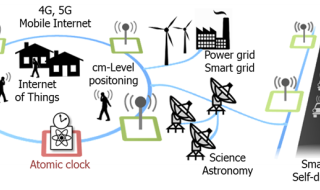Use case: SuperGPS - super accurate positioning via optical network
GPS is good at positioning in large open spaces without obstacles, such as oceans and deserts. But in urban areas, with all their tall buildings, accurate positioning with satellite signals is more difficult. SuperGPS chooses a different solution: a combination of an optical fiber network and radio transmitters on buildings and along streets.
Christian Tiberius is a senior lecturer at the Faculty of Civil Engineering at Delft University of Technology. He is one of the project leaders of SuperGPS. "We started this project in 2016, in collaboration with VU Amsterdam, where Jeroen Koelemeij already worked on time and frequency distribution via fiber optics. We already had a lot of knowledge about the use of broadband radio signals. We were able to combine these two areas of expertise. The project now lies entirely with us, and I lead it together with my colleague Gerard Janssen from Electrical Engineering.

: SuperGPS - The fiber optic network, to which an atomic clock is connected, is represented by the blue line. In the green frames are the radio stations connected to the network. They transmit time signals wirelessly to e.g. self-driving cars. Image: TU Delft
Ships on oceans
The basic idea of SuperGPS is that positions are not determined using radio signals from satellites, but with a combination of an optical fiber network and radio transmitters at buildings and along streets. Tiberius explains the advantage this brings. "The U.S. military invented GPS to locate ships on oceans, military vehicles in the desert and airplanes in the air. It works fine there. Since there are hardly any obstacles, you always have a direct view with the satellites. Nowadays, consumers too use GPS for many applications, including navigation. And soon we'll also need it for self-driving cars.
Self-driving cars and road safety
And with that application you see a disadvantage of GPS: especially in urban areas there are many obstacles. A GPS device receives radio signals from satellites, both directly and reflected from buildings. Result: the positioning sometimes deviates hundreds of meters. Tiberius: "For navigation purposes, this is not too problematic: your device will correct this deviation, using the installed map. But if we want to do the positioning for self-driving cars, positioning needs to be a lot more accurate. Road safety is at stake here.
Atomic clock at VSL
SuperGPS makes it possible to determine the position of a vehicle to up to 1 or 2 decimetres, enough to allow it to safely participate in traffic. How does this work? Tiberius: "The basis of SuperGPS is an optical network that is connected to an atomic clock (in our case one from the VSL metrology institute in Delft), which enables the network to transmit very accurate time pulses. Transmitters are connected to that network. They are located along roads, or attached to buildings, and send radio signals to the objects of which you want to determine the location, in our case self-driving cars".
By expanding its network to accommodate this technology, SURF has played a role in making the time distribution of VSL's atomic clock available to Delft University of Technology. SURF has also installed the equipment which communicates with the atomic clock and which transmits the time pulses to the radio stations located along the road, for example, as shown in the image.

Christiaan Tiberius
Accurate to 100 picoseconds
Experiments have already been conducted with SuperGPS. Tiberius: "Many projects result in papers, articles or other documents. We said at the beginning: we really want to make this work in a practical way. That's why we took the test in The Green Village - an existing experimental garden at TU Delft. We hung a transmitter box on 6 lampposts. Each transmitter was connected to the fiber optic network on which the atomic clock distributed the time. We then drove a car equipped with a receiver, and checked whether the system could determine the position of the car accurately enough, i.e. to 1 to 2 decimeters. This turned out to be the case!
The optical network delivered the time signal from VSL to each radio station with an accuracy of 100 picoseconds. The radio stations then transmitted their signals, which the car used to determine its position. A deviation of 100 picoseconds (1 picosecond = 1 trillionth second) corresponds to an error in the measured distance of 3 centimeters. However, there are other sources of error in the system (e.g. thermal noise in the electronics), which ultimately results in an accuracy of 1 to 2 decimeters".
Serious interest
Of course, SuperGPS currently has no end users: it is still a prototype, and there is still a long way to go before there is suitable equipment for the end user. But Tiberius does expect SuperGPS to be deployed. "At the Dutch Research Council (NWO), which financed the project, we have a large user committee consisting of large companies and institutes such as KPN and TNO. This indicates that there is serious interest in SuperGPS.”
